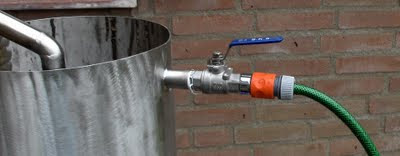Saturday the 2th of july I held a party celebration to inaugurate my new still.
To do so I used the lavender I picked in Ulvenhout the week before. The lavender (Lavandula angustifolia var.litte lady) was well dried in the past few days.
The weight of the dried lavender was 2.7 kg. I had failed to weigh the freshly picked lavender, especially as the lavender was still wet from the drizzle.
The percentage essential oil is therefore only to be calculated derived from the dried lavender
With this amount of lavender the still was filled 1/3
After closing of the kettle and fill the bucket with lukewarm coolingwater it was the moment to lit the burner. Here we have had an official moment for toasting with homemade elderflower champ. This super liquor made by Catharina tasted good!
For the distillation I used a glass Florentine vase. That would be easier for me during the distillation, and it made the separation of hydrosol and essential oil visible for the guests.
It took over half an hour before the water in the kettle began to boil, and ten minutes later the first distillate started to run. At the beginning of the distillation, there was little to see
 But gradually a thin layer formed of oil on the hydrosol in the Florentine vase. From almost colorless to light yellow the essential oil was changing in color. Also the fragrance tof the oil produced was changing during the destillation.
But gradually a thin layer formed of oil on the hydrosol in the Florentine vase. From almost colorless to light yellow the essential oil was changing in color. Also the fragrance tof the oil produced was changing during the destillation. What was remarkable was that while distilling the cold bucket of lukewarm water I had filled before did not need adding coolingwater. The top of the bucket was hot, the middele medium hot and the bottom cold.
 |
| Essential oil is transferred from the Florentine vase in a separating funnel |
After two hours distilling when the party gaining momentum came, I turned off the burner.
The yield was about 70 mL. After transferring from the Florentine vase in a separating funnel ...
The yield was about 70 mL. After transferring from the Florentine vase in a separating funnel ...
... after filtration there was remaining 60 mL of lavender oil.
 |
| after the distillation of lavender |
To let the kettle cool down faster, I removed the lid, and the water
was released from the boiler drain. The distillation was successful beyond my expectations and without having to regulate temperature and water supply
Now I know that if the still is completely filled with the dried lavender 200 mL of essential oil can be made. The party could really begin!




















































